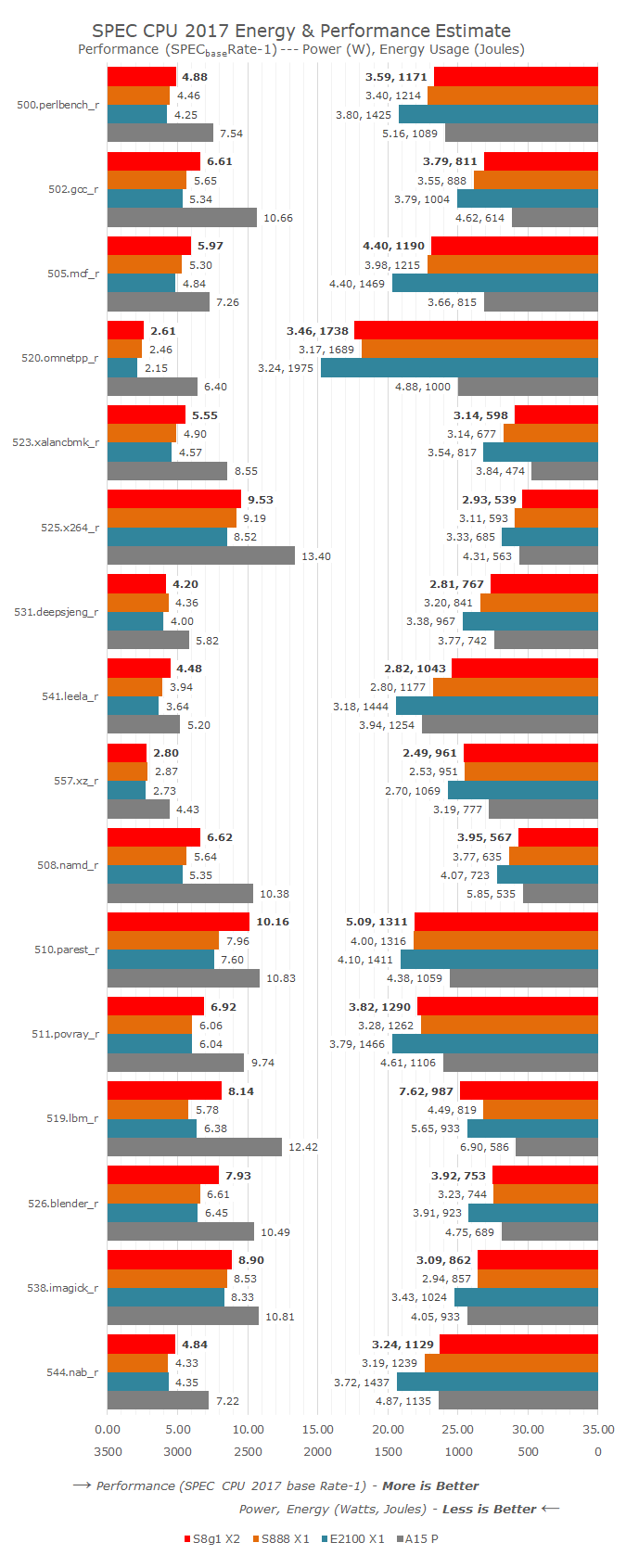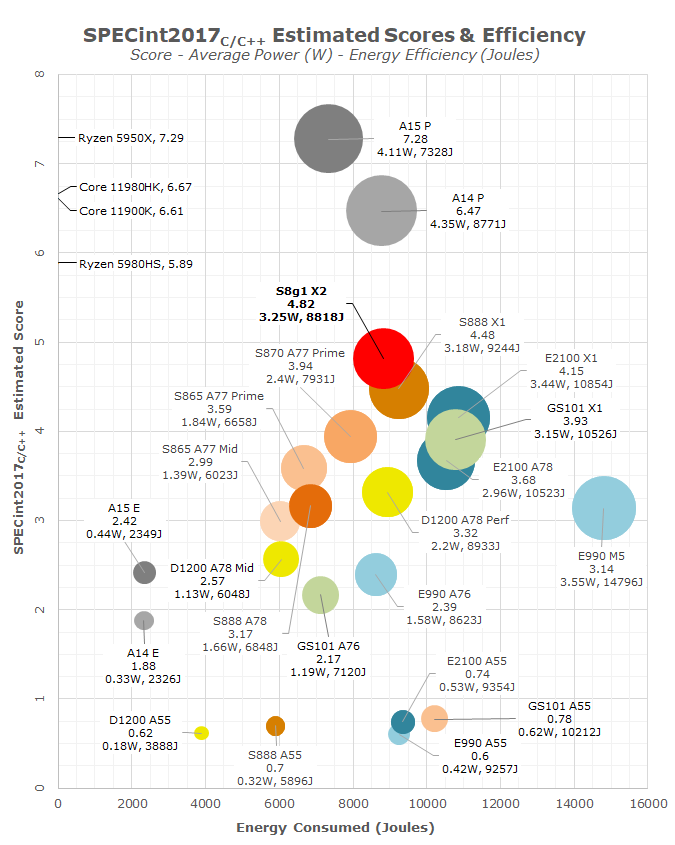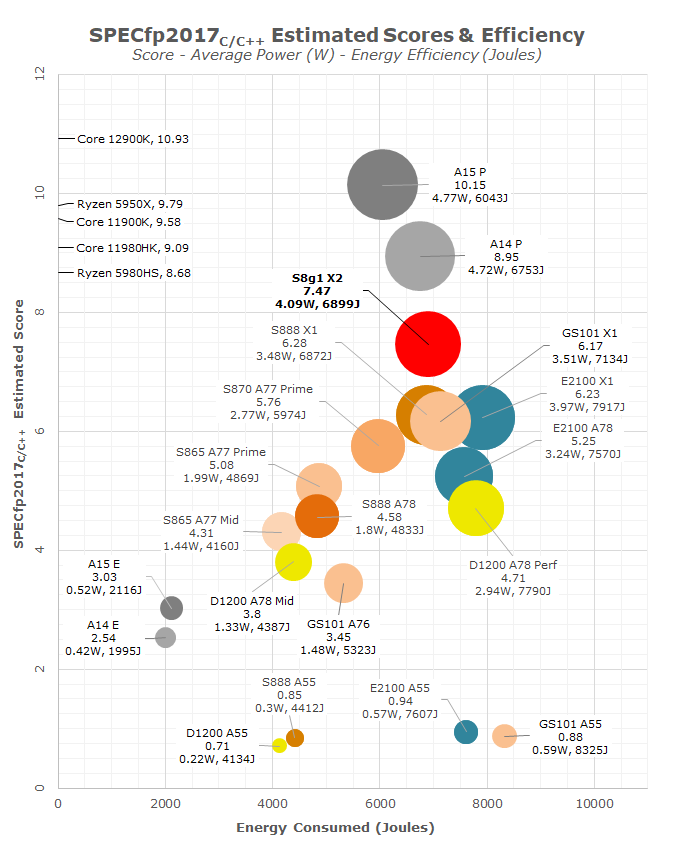The Snapdragon 8 Gen 1 Performance Preview: Sizing Up Cortex-X2
by Dr. Ian Cutress on December 14, 2021 8:00 AM ESTTesting the Cortex-X2: A New Android Flagship Core
Improving on the Cortex-X1 by switching to the Arm v9 architecture and increasing the core resources, both Arm and Qualcomm are keen to promote that the Cortex-X2 offers better performance and responsiveness than previous CPU cores. The small frequency bump from 2.85 GHz to 3.00 GHz will add some of that performance, however the question is always if the new manufacturing process coupled with the frequency increase allows for better power efficiency when running these workloads. Our standard analysis tool here is SPEC2017.
Running through some of these numbers, there are healthy gains to the core, and almost everything has a performance lift.
On the integer side (from 500.perlbench to 557.xr), there are good gains for gcc (+17%), mcf (+13%), xalancbmk (+13%), and leela (+14%), leading to an overall +8% improvement. Most of these integer tests involve cache movement and throughput, and usually gains in sub-tests like gcc can help a wide range of regular user workloads.
Looking at power and energy for the integer benchmarks, we’re seeing the X2 consume more instantaneous power on almost all the tests, but the efficiency is kicking in. That overall 8% performance gain is taking 5% less total energy, but on average requires 2% more peak power.
If we put this core up against all the other performance cores we test, we see that 8% jump in performance for 5% less energy used, and the X2 stands well above the X1 cores of the previous generation, especially those in non-Snapdragon processors. There is still a fundamental step needed to reach the Apple cores, even the previous-generation A14 performance core, which scores 34% higher for the same energy consumed (albeit on average another 34% peak power).
Just on these numbers, Qualcomm’s +20% performance or +30% efficiency doesn’t bare fruit, but the floating point numbers are significantly different.
Several benchmarks in 2017fp are substantially higher on the X2 this generation. +17% on namd for example would point to execution performance increases, but +28% in parest, +41% in lbm and +20% in blender showcases a mix of execution performance and memory performance. Overall we’re seeing +19% performance, which is nearer Qualcomm’s 20% mark. Note that this comes with an almost identical amount of energy consumed relative to the X1 core in the S888, with a difference of just 0.2%.
The major difference however is the average power consumed. For example, our biggest single test gain in 519.lbm is +41%, but where the S888 averages 4.49 watts, the new X2 core averages 7.62 watts. That’s a 70% increase in instantaneous power consumer, and realistically no single core in a modern smartphone should draw that much power. The reason why the power goes this high is because lbm leverages the memory subsystem, especially that 6 MiB L3 cache and relies on the 4 MiB system level cache, all of which consumes power. Overall in the lbm test, the +41% performance costs +20% energy, so efficiency is still +16% in this test. Some of the other tests, such as parest and blender, also follow this pattern.
Comparing against the competition, the X2 core does make a better generation jump when it comes to floating point performance. It will be interesting to see how other processors enable the X2 core, especially MTK’s flagship at slightly higher frequency, on TSMC N4, but also if it has access to a full 14 MiB combination of caches as we suspect, that could bring the power draw during single core use a lot higher. It will be difficult to tease out exactly who wins what where based on implementation vs. process node, but it will be a fun comparison to make when we look purely at the X2 vs. X2 cores.
Unfortunately due to how long SPEC takes to run (1h30 on the X2), we were unable to test on the A710/A510. We’ll have to wait to see when we get a retail unit.













169 Comments
View All Comments
StevoLincolnite - Wednesday, December 15, 2021 - link
We have reached a point where even a low-range phone is "good enough" for 90% of users out there... Usually the draw backs of those devices tend to be in the display (LCD) or camera sensors rather than how snappy the device is.Today I walked into a store to see what I could upgrade my Samsung Galaxy Note 20 Ultra 5G to.. It's been 18 months and from a camera and display perspective, nothing was really worth dropping another $2,000 AUD on... Because I am not going to perceive any difference in device snappiness... Even though I keep it in power saving mode 24/7 for increased battery life anyway.
TheinsanegamerN - Friday, December 17, 2021 - link
Moto g power 2020, has a snapdragon 665, 1080p display, and stereo speakers alongside a huge battery for $229. With phones like that, I have no idea why people were buying $1400+ flagships.Of course now manufacturers are cheaping out, using 720p displays and mediatek chips to push you towards their $500-600 mid range ptions.
Bd0N - Wednesday, December 15, 2021 - link
Here’s where having a processor that’s more than “fast enough” matters. Software grows in complexity over time and Apple’s devices get updates for 6-8 years. What may seem like unnecessary performance now ensures that devices feel snappy throughout their lifetime. Your S865 would be struggling to support software that much younger than it. But of course you don’t get updates for that long and that’s why iPhones have a higher resell value.nucc1 - Thursday, December 16, 2021 - link
I can buy another mid range android every 24 months to keep up with software bloat and still come out ahead in dollar terms vs iPhone :)TheinsanegamerN - Friday, December 17, 2021 - link
Android phones dont need updates to continue getting new software. You can buy an android phone running android 6 and still play all the latest games and apps.Iphones, OTOH, are screwed once updates stop for 1-2 years. Effectively both brands have the same lifespan, the difference being iphones are cut off by apple instead of developers.
iphonebestgamephone - Friday, December 17, 2021 - link
Wrong. Both the citra 3ds emulator and aethersx2 ps2 emulator need android 8 and 7 respectively. Genshin impact and dead by daylight need 7. There's prolly a lot more.Reflex - Monday, December 20, 2021 - link
This is factually incorrect, Google is fairly aggressively cutting off support for older versions of Android for app developers, and they are right to do so for security reasons. What they have not done is meaningfully extended the support lifecycle for hardware, so you get the worst of both worlds: Short support lifecycle and hardware that is decreasingly useful due to the app library thinning with every app update.Nicon0s - Saturday, December 18, 2021 - link
"Here’s where having a processor that’s more than “fast enough” matters. Software grows in complexity over time and Apple’s devices get updates for 6-8 years. What may seem like unnecessary performance now ensures that devices feel snappy throughout their lifetime. Your S865 would be struggling to support software that much younger than it."I wound wager that "his 865" will do just as fine long term as the A13, the generational equivalent from Apple. The CPU is no the only relevant component for performance when looking at a phone. Other component like RAM, Storage and Wireless connection efficiency and performance are also very very important. The A13 isn't even faster in multi-core which is just becoming more and more important as times goes by and especially with Android which a more multi-core oriented system than iOS.
Kangal - Sunday, December 19, 2021 - link
That's true.However, an iPhone will still age better than any Android device. That's the perks of having vertical integration. You'll have more optimised hardware, more optimised software, and more optimised third-party support.
For instance:
iPhone 5S (A7) vs (QSD 800) Samsung Note 3
iPhone 6S+ (A9) vs (QSD 810) Sony Z5 Premium
iPhone 8+ (A11) vs (QSD 835) Google Pixel 2XL
iPhone 11 Max (A13) vs (QSD 855) ASUS RoG 2
And these are what I thought were strong competitors. For general use stuff, Apple wins. While it has some obvious drawbacks. And I can admit this as an Android user, credit where it's due.
Nicon0s - Saturday, December 25, 2021 - link
"You'll have more optimised hardware, more optimised software, and more optimised third-party support."I keep hearing this but it's not like hardware and software is only integrated and optimized on Apple devices.
"And these are what I thought were strong competitors."
I don't think those "were strong competitors", you just picked a few random phones and compared them.
Like I've said the CPU is not the only relevant component. The SD 865 has a stronger GPU in sustained performance and much better connection performance. Also most SD 865 phones have 8GB of RAM. So in the long run it won't fare worse than iphones with the A13 as it's not a less capable and less efficient SOC it only scores lower in CPU benchmarks.